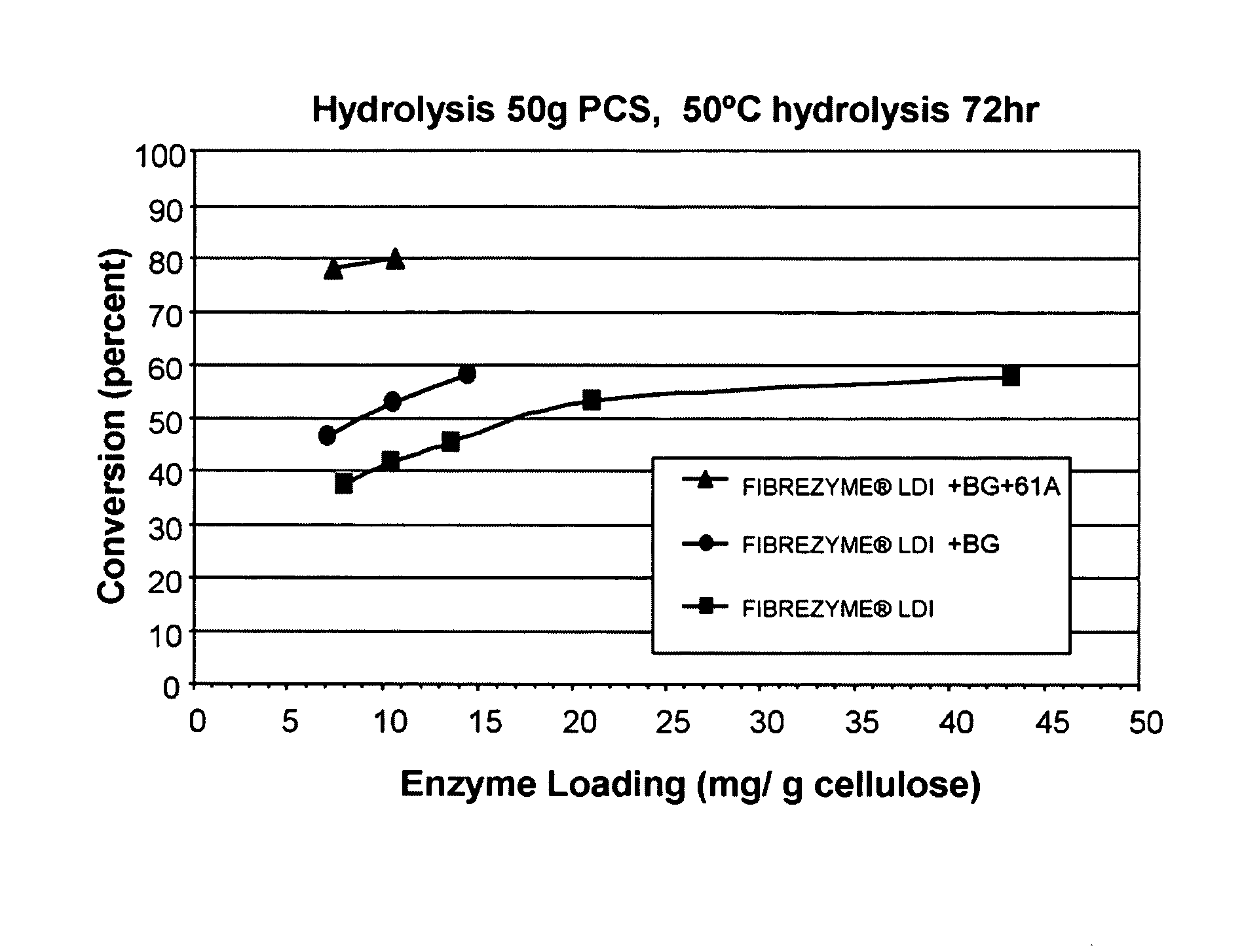Compositions and methods for enhancing the degradation or conversion of cellulose-containing material
a technology of cellulose-containing materials and compositions, which is applied in the direction of peptides, plant/algae/fungi/lichens ingredients, bulk chemical production, etc., can solve the problems of limited utility of commercial cellulolytic enzyme preparations for the degradation and conversion of cellulose-containing materials
- Summary
- Abstract
- Description
- Claims
- Application Information
AI Technical Summary
Benefits of technology
Problems solved by technology
Method used
Image
Examples
example 1
Preparation of Thermoascus aurantiacus Polypeptide Gh61A Having Cellulolytic Enhancing Activity and Aspergillus oryzae Beta-Glucosidase
[0459]A Thermoascus aurantiacus polypeptide GH61A having cellulolytic enhancing activity and Aspergillus oryzae beta-glucosidase were prepared by overexpression in Aspergillus oryzae The Thermoascus aurantiacus polypeptide GH61A having cellulolytic enhancing activity was recombinantly produced in Aspergillus oryzae JaL250 according to WO 2005 / 074656. The Aspergillus oryzae beta-glucosidase was recombinantly produced in Aspergillus oryzae JaL250 according to WO 02 / 095014.
[0460]Fermentor cultures were grown by cultivating Aspergillus oryzae cultures on NNCYP medium supplemented with 52 g of cellulose per liter, which was batched in during fermentation (no additional carbon source) at 42° C. and maintained at pH 5.0. The fermentation was allowed to run until the batch cellulose had been exhausted (typically about 40 hours) at which time the broth was ha...
example 2
Pretreatment of Corn Stover
[0462]Corn stover was pretreated at the U.S. Department of Energy National Renewable Energy Laboratory (NREL) using dilute sulfuric acid. The following conditions were used for the pretreatment: 1.4 wt % sulfuric acid at 195° C. for 4.5 minutes. According to limit digestion with excess cellulase enzymes, the water-insoluble solids in the pretreated corn stover (PCS) contained 59.5% cellulose. Prior to enzymatic hydrolysis, the PCS was washed with a large volume of deionized water until soluble acid and sugars were removed. The dry weight of the water-washed PCS was found to be 19.16%.
example 3
Cellulolytic Enhancing Activity of Thermoascus aurantiacus Polypeptide GH61A when Combined with Aspergillus oryzae Beta-Glucosidase and FIBREZYME® LDI Cellulase
[0463]Hydrolysis of PCS was conducted using 125 ml screwtop Erlenmeyer flasks (VWR, West Chester, Pa., USA) using a total reaction mass of 50 g as per NREL Laboratory Analytical Protocol #008. In this protocol hydrolysis of PCS (approximately 11.4% in PCS and 6.8% cellulose in aqueous 50 mM sodium acetate pH 5.0 buffer) was performed using different protein loadings (expressed as mg of enzyme per gram of cellulose) of a FIBREZYME® LDI sample (Dyadic International, Inc., Jupiter, Fla., USA) in the absence and presence of 6% Aspergillus oryzae beta-glucosidase of cellulase protein loading with and without addition of 11% Thermoascus aurantiacus GH61A. Testing of PCS hydrolyzing capability was performed at 50° C. with orbital shaking at 150 rpm (INNOVA® 4080 Incubator, New Brunswick Scientific, Edison, N.J., USA). Aliquots were ...
PUM
| Property | Measurement | Unit |
|---|---|---|
| pH | aaaaa | aaaaa |
| Tm | aaaaa | aaaaa |
| Tm | aaaaa | aaaaa |
Abstract
Description
Claims
Application Information
 Login to View More
Login to View More - R&D
- Intellectual Property
- Life Sciences
- Materials
- Tech Scout
- Unparalleled Data Quality
- Higher Quality Content
- 60% Fewer Hallucinations
Browse by: Latest US Patents, China's latest patents, Technical Efficacy Thesaurus, Application Domain, Technology Topic, Popular Technical Reports.
© 2025 PatSnap. All rights reserved.Legal|Privacy policy|Modern Slavery Act Transparency Statement|Sitemap|About US| Contact US: help@patsnap.com

